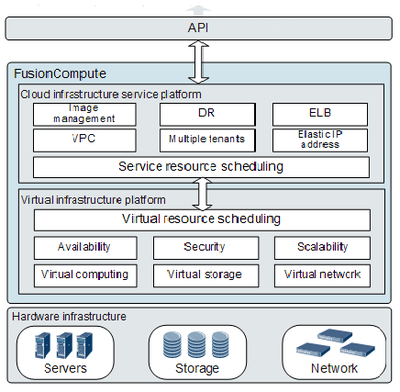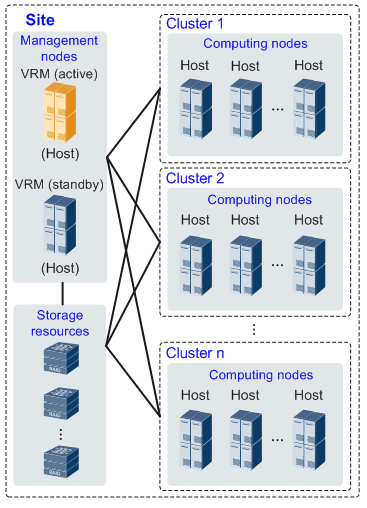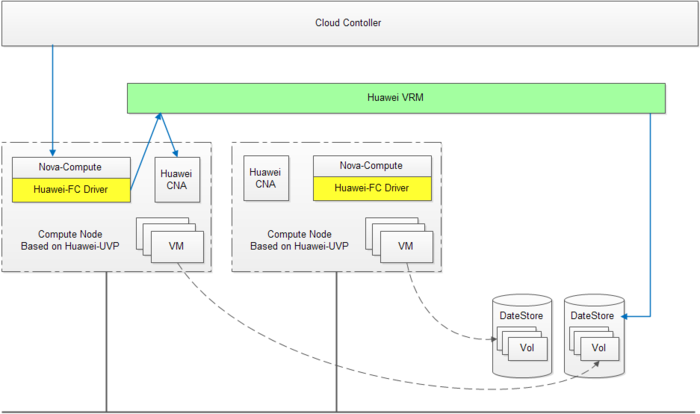Difference between revisions of "FusionCompute"
(→Overview) |
(→Overview) |
||
| Line 37: | Line 37: | ||
* '''IMGS''': Image Storage.<br/> | * '''IMGS''': Image Storage.<br/> | ||
| − | * '''UVP''': The hypervisor of Huawei FusionCompute.<br/> | + | * '''UVP''': The hypervisor of Huawei FusionCompute based on SuSE.<br/> |
| − | == How FusionCompute works with Nova? | + | == How FusionCompute works with Nova? == |
The basic architecture can be shown as below: | The basic architecture can be shown as below: | ||
[[File:FusionCompute with Nova.png|700px|thumbnail|center]] | [[File:FusionCompute with Nova.png|700px|thumbnail|center]] | ||
| − | == Configure == | + | === Note === |
| + | - The package of nova-compute is deployed on the Huawei-CNA nodes. | ||
| + | - Nova-scheduler will select the suitable compute-hosts based on the reported resource as usual. | ||
| + | - Nova won't communicate with Huawei-VRM directly, the Huawei-FC Driver will be the bridge between them. | ||
| + | |||
| + | === Example === | ||
| + | |||
| + | Let's give an example for creating an instance: | ||
| + | |||
| + | 1. Nova API receives a request for creating. | ||
| + | 2. Nova Scheduler chooses a suitable host based on configure as usual. | ||
| + | 3. Nova Compute receives the request, gets IP/mac info from neutron, and calls the spawn() on Huawei-FC Driver. | ||
| + | 4. The Huawei-FC Driver sends the request to Huawei-VRM from the CNA node. | ||
| + | 5. The Huawei-VRM choose the last node, and starts to create instance. | ||
| + | |||
| + | == Deploy & Configure == | ||
Drafting | Drafting | ||
Revision as of 09:21, 9 December 2013
Contents
Overview
FusionCompute is a fully Huawei in-house developed computing virtualization software. FusionCompute provides the tuned high-performance and high reliabilities in VM instance provisioning, clustered resource pool management, and intelligent HA/FT scheduling.
The overview of it can be illustrated as below:
Benefits
Drafting
Topology
The figure below shows the logical nodes in the FusionCompute.
Modules
- VRM: Virtual Resource Management, core controller nodes of FusionCompute.
- Manages block storage resources in the cluster.
- Allocates private IP addresses for virtual machines (VMs) by using Dynamic Host Configuration Protocol (DHCP).
- Manages nodes in the computing cluster and maps physical computing resources to virtual computing resources.
- Manages network resources, such as IP addresses, virtual local area network (VLAN) numbers, security groups, and DHCP severs in the cluster and allocates private IP addresses to non-VPC VMs.
- Manages the life cycle of VMs in the cluster and distributes and migrates VMs across CNAs.
- Dynamically adjusts resources in the cluster.
- Implements centralized management of virtual resources and user data and provides elastic computing, storage, and IP address services.
- Allows O&M engineers to remotely access the FusionCompute through a web interface to perform resource monitoring and management and view resource statistics reports.
- CNA: Computing Node Agent, deploys on each compute nodes.
- Implements the virtual computing function.
- Manages the VMs running on the CNA.
- Manages the computing, storage, and network resources of the CNA.
- IMGS: Image Storage.
- UVP: The hypervisor of Huawei FusionCompute based on SuSE.
How FusionCompute works with Nova?
The basic architecture can be shown as below:
Note
- The package of nova-compute is deployed on the Huawei-CNA nodes. - Nova-scheduler will select the suitable compute-hosts based on the reported resource as usual. - Nova won't communicate with Huawei-VRM directly, the Huawei-FC Driver will be the bridge between them.
Example
Let's give an example for creating an instance:
1. Nova API receives a request for creating. 2. Nova Scheduler chooses a suitable host based on configure as usual. 3. Nova Compute receives the request, gets IP/mac info from neutron, and calls the spawn() on Huawei-FC Driver. 4. The Huawei-FC Driver sends the request to Huawei-VRM from the CNA node. 5. The Huawei-VRM choose the last node, and starts to create instance.
Deploy & Configure
Drafting



